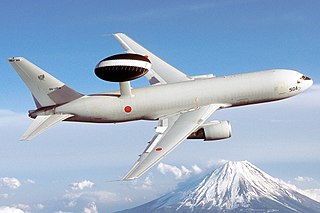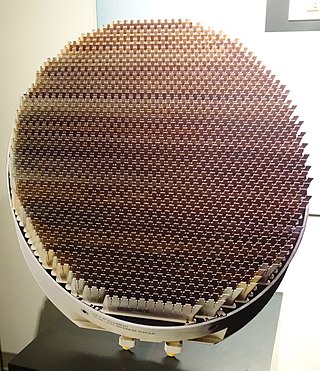
The Boeing E-3 Sentry is an American airborne early warning and control (AEW&C) aircraft developed by Boeing. E-3s are commonly known as AWACS. Derived from the Boeing 707 airliner, it provides all-weather surveillance, command, control, and communications, and is used by the United States Air Force, NATO, French Air and Space Force, Royal Saudi Air Force and Chilean Air Force. The E-3 has a distinctive rotating radar dome (rotodome) above the fuselage. Production ended in 1992 after 68 aircraft had been built.

The Northrop Grumman E-8 Joint Surveillance Target Attack Radar System is a retired United States Air Force (USAF) airborne ground surveillance, battle management and command and control aircraft. It tracked ground vehicles and some aircraft, collected imagery, and relayed tactical pictures to ground and air theater commanders. Until its retirement in 2023 the aircraft was operated by both active duty USAF and Air National Guard units, with specially trained U.S. Army personnel as additional flight crew.

The Northrop Grumman E-2 Hawkeye is an American all-weather, carrier-capable tactical airborne early warning (AEW) aircraft. This twin-turboprop aircraft was designed and developed during the late 1950s and early 1960s by the Grumman Aircraft Company for the United States Navy as a replacement for the earlier, piston-engined E-1 Tracer, which was rapidly becoming obsolete. The aircraft's performance has been upgraded with the E-2B and E-2C versions, where most of the changes were made to the radar and radio communications due to advances in electronic integrated circuits and other electronics. The fourth major version of the Hawkeye is the E-2D, which first flew in 2007. The E-2 was the first aircraft designed specifically for AEW, as opposed to a modification of an existing airframe, such as the Boeing E-3 Sentry. Variants of the Hawkeye have been in continuous production since 1960, giving it the longest production run of any carrier-based aircraft.

An airborne early warning and control (AEW&C) system is an airborne radar early warning system designed to detect aircraft, ships, vehicles, missiles and other incoming projectiles at long ranges, as well as performing command and control of the battlespace in aerial engagements by informing and directing friendly fighter and attack aircraft. AEW&C units are also used to carry out aerial surveillance over ground and maritime targets, and frequently perform battle management command and control (BMC2). When used at altitude, the radar system on AEW&C aircraft allows the operators to detect, track and prioritize targets and identify friendly aircraft from hostile ones in real-time and from much farther away than ground-based radars. Like ground-based radars, AEW&C systems can be detected and targeted by opposing forces, but due to aircraft mobility and extended sensor range, they are much less vulnerable to counter-attacks than ground systems.

The Boeing E-7 Wedgetail, also marketed as the Boeing 737 AEW&C, is a twin-engine airborne early warning and control aircraft based on the Boeing 737 Next Generation design. It has a fixed, active electronically scanned array radar antenna instead of a rotating one as with the 707-based Boeing E-3 Sentry. The E-7 was designed for the Royal Australian Air Force (RAAF) under "Project Wedgetail" and designated E-7A Wedgetail.
The Northrop Grumman E-10 MC2A was planned as a multi-role military aircraft to replace the Boeing 707-based E-3 Sentry and E-8 Joint STARS, the Boeing 747-based E-4B, and the RC-135 Rivet Joint aircraft in US military service. The E-10 was based on the Boeing 767-400ER commercial airplane.

An active electronically scanned array (AESA) is a type of phased array antenna, which is a computer-controlled antenna array in which the beam of radio waves can be electronically steered to point in different directions without moving the antenna. In the AESA, each antenna element is connected to a small solid-state transmit/receive module (TRM) under the control of a computer, which performs the functions of a transmitter and/or receiver for the antenna. This contrasts with a passive electronically scanned array (PESA), in which all the antenna elements are connected to a single transmitter and/or receiver through phase shifters under the control of the computer. AESA's main use is in radar, and these are known as active phased array radar (APAR).

The Northrop Grumman MQ-4C Triton is an American high-altitude long endurance unmanned aerial vehicle (UAV) developed for and flown by the United States Navy and Royal Australian Air Force as a surveillance aircraft. Together with its associated ground control station, it is an unmanned aircraft system (UAS). Developed under the Broad Area Maritime Surveillance (BAMS) program, the Triton is intended to provide real-time intelligence, surveillance and reconnaissance missions (ISR) over vast ocean and coastal regions, continuous maritime surveillance, conduct search and rescue missions, and to complement the Boeing P-8 Poseidon maritime patrol aircraft.
Northrop Grumman Electronic Systems (NGES) was a business segment of Northrop Grumman from 1996 to 2015, until a reorganization on January 1 2016 merged other Northrop Grumman businesses into NGES to form a new segment called Mission Systems. NGES had originally been created by Northrop Grumman's acquisition of Westinghouse Electronic Systems Group in 1996. The Electronic Systems sector was a designer, developer, and manufacturer of a wide variety of advanced defense electronics and systems. The division had 120 locations worldwide, including 72 international offices, and approximately 24,000 employees; accounting for 20% of company sales in 2005.

The Erieye radar system is an Airborne Early Warning and Control System (AEW&C) developed by Saab Electronic Defence Systems, formerly Ericsson Microwave Systems, of Sweden. It uses active electronically scanned array (AESA) technology. The Erieye is used on a variety of aircraft platforms, such as the Saab 340 and Embraer R-99. It has recently been implemented on the Bombardier Global 6000 aircraft as the GlobalEye.

The EL/M-2075 Phalcon is an airborne early warning and control (AEW&C) active electronically scanned array radar system developed by Israel Aerospace Industries (IAI) and Elta Electronics Industries of Israel. Its primary objective is to provide intelligence to maintain air superiority and conduct surveillance. It was surpassed by newer versions—the EL/W-2085 and the EL/W-2090.

A passive electronically scanned array (PESA), also known as passive phased array, is an antenna in which the beam of radio waves can be electronically steered to point in different directions, in which all the antenna elements are connected to a single transmitter and/or receiver. The largest use of phased arrays is in radars. Most phased array radars in the world are PESA. The civilian microwave landing system uses PESA transmit-only arrays.

The Boeing E-767 is an Airborne Warning and Control System (AWACS) aircraft that was designed in response to the Japan Air Self-Defense Force's requirements. It is essentially the Boeing E-3 Sentry's surveillance radar and air control system installed on a Boeing 767-200.

The AN/APG-81 is an active electronically scanned array (AESA) fire-control radar system designed by Northrop Grumman Electronic Systems for the Lockheed Martin F-35 Lightning II.
Electronics and Radar Development Establishment (LRDE) is a laboratory of the Defence Research & Development Organisation (DRDO), India. Located in C.V. Raman Nagar, Bengaluru, Karnataka, its primary function is research and development of radars and related technologies. It was founded by S. P. Chakravarti, the father of electronics and telecommunication engineering in India, who also founded the Defence Electronics Research Laboratory and Defence Research and Development Laboratory.

The KLJ-7, also referred to as the Type 1478, is an X band airborne fire-control radar (FCR) developed by Nanjing Research Institute of Electronic Technology (NRIET), also known as the China Electronics Technology Company's (CETC's) No. 14 Research Institute. In December 2010, Pakistan Air Force's Air Chief Marshal Rao Qamar Suleman announced that KLJ-7 radar will be built at Pakistan Aeronautical Complex (PAC), in Kamra, north of Islamabad.

The DRDO Airborne Early Warning and Control System (AEW&CS) is a project of India's Defence Research and Development Organisation to develop an airborne early warning and control system for the Indian Air Force. It is also referred to as NETRA Airborne Early Warning and Control System (AEW&CS).

The EL/W-2085 is an airborne early warning and control (AEW&C) multi-band radar system developed by Israel Aerospace Industries (IAI) and Elta Electronics Industries of Israel. Its primary objective is to provide intelligence to maintain air superiority and conduct surveillance. The system is currently in-service with Israel, Italy, and Singapore.
The AN/APY-10 is an American multifunction radar developed for the U.S. Navy's Boeing P-8 Poseidon maritime patrol and surveillance aircraft. AN/APY-10 is the latest descendant of a radar family originally developed by Texas Instruments, and now Raytheon after it acquired the radar business of TI, for Lockheed P-3 Orion, the predecessor of P-8.















